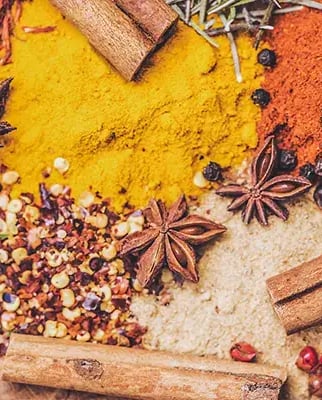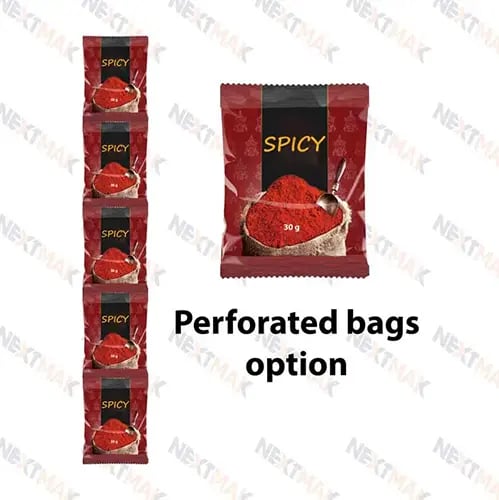Talk with us on WhatsApp: +90 535 106 7000
SPICES & SEASONING PACKAGING
NEXTMAK.COM > SOLUTIONS > SPICES PACKAGING
Spices are among the most important ingredients added to foods, as they give a distinctive taste to the food. In the past, they were considered one of the most important strategic products for which wars were waged to secure their trade routes and access.
Spices are dried seeds, fruits, roots, bark, or other plant substances used primarily for flavoring, coloring, or preserving food.
Some examples of popular spices include:
Black pepper: made from the unripe berries of the pepper plant, used to add a pungent, spicy flavor to food.
Cumin: seeds of the cumin plant, used to add a nutty, earthy flavor to food.
Turmeric: a root of the turmeric plant, used to add a warm, bitter flavor to food.
Paprika: made from ground, dried peppers, used to add a smoky, sweet flavor to food.
Cinnamon: made from the bark of the cinnamon tree, used to add a warm, sweet flavor to food.
Nutmeg: made from the seed of the nutmeg tree, used to add a warm, sweet, and woodsy flavor to food.
Cardamom: made from the seeds of the cardamom plant, used to add a sweet, lemony flavor to food.
Cloves: dried, unopened flower buds of the clove tree, used to add a warm, sweet and fragrant flavor to food.
Ginger: made from the root of the ginger plant, used to add a warm, spicy flavor to food.
Saffron: made from the dried stigmas of the saffron crocus, used to add a unique and flavorful taste to food.
Mustard seed: comes in black, brown, and yellow varieties used to add a pungent, spicy flavor to food.
Coriander: made from the seeds of the cilantro plant, used to add a citrusy, nutty flavor to food.
Fenugreek: made from the seeds of the fenugreek plant, used to add a slightly bitter, maple-like flavor to food.
Star Anise: dried fruit of an evergreen tree, used to add a licorice-like flavor to food.
Dill: made from the leaves and seeds of the dill plant, used to add a mild, sweet, and fresh flavor to food.
Oregano: made from the leaves of the oregano plant, used to add a strong, earthy, and slightly bitter flavor to food.
Rosemary: made from the leaves of the rosemary plant, used to add a fragrant, piney, and slightly minty flavor to food.
Bay leaves: made from the leaves of the bay laurel tree, used to add a subtle, woodsy, and minty flavor to food.
Cilantro: made from the leaves of the cilantro plant, used to add a fresh, tangy, and slightly bitter flavor to food.
Allspice: made from the dried berries of the Pimenta dioica tree, used to add a warm, sweet, and slightly spicy flavor to food.
SPICES and SEASONING
Flexible packaging for spices typically includes materials such as foil, film, and paper. Some examples of flexible packaging for spices include:
Stand-up pouches: These are a popular form of flexible packaging for spices. They are made from a flexible material, such as foil or film, and have a bottom gusset that allows the pouch to stand upright. They can be designed with a re-sealable zipper to keep the spices fresh.
Foil bags: Foil bags are another popular form of flexible packaging for spices. They are made from aluminum foil, which provides an excellent barrier against light, air, and moisture.
Vacuum pouches: Spices can be packaged in vacuum pouches, which are made from a laminated material that is designed to remove the air inside the pouch before sealing. This helps to preserve the freshness and aroma of the spices.
Cellophane bags: Cellophane bags are a clear, thin, and flexible packaging option for spices. They are made from a cellulose material, which allows for a good barrier against light and air.
Flow wraps: Spices can be packaged in a flow wrap, which is a continuous tube of plastic film that is folded and sealed to create a package.
All of these packaging methods have their own advantages and disadvantages, and the best choice would depend on the spice, the intended shelf life, and the desired level of protection.
FLEXIBLE PACKAGING OF THE SPICES
© 2024 NEXTMAK | PRODUCTS | SOLUTIONS | SUPPORT | REFERENCES | CONTACT | GET A QUOTE
ERAS PACK AMBALAJ
VE MAKİNE SAN. TIC. LTD. STI.
Address
İkitelli OSB, Saraçlar Sanayi Sitesi, Blok: 7
Başakşehir / Istanbul / TÜRKİYE
TEL/WhatsApp: +90 535 106 7000
TEL/WhatsApp: +90 536 662 3672
Email: export@nextmak.com - info@nextmak.com




